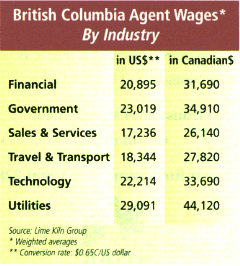W |
hoever said ignorance is bliss obviously wasn’t looking to site a facility, especially not a call center. And when ignorance means missing out on 40-50 percent in labor costs savings … well it could mean blissful unemployment. But on behalf of those not knowing that Canada’s British Columbia (BC) could save their firms that amount of money, it is not all their fault. British Columbia didn’t have objective information about average wages for call center agents and supervisors until now.
In April, Victoria, B.C.-based Lime Kiln Group (viatec.bc.ca/thelime.htm) was retained by Linx BC (www.linxbc.com), a public-private economic development group, to study the province’s call center industry. Lime Kiln’s objective was to develop a baseline of wages, work environment, turnover and other issues central to the differentiation of BC’s call center industry within the North American marketplace.
 The study found that starting wages for BC agents range between US$6.25 and $13.40 per hour, with a weighted average of $8.96. At the supervisory level, starting annual wages average $26,430, and average annual wages move up to $29,630, reports Lime Kiln. With benefits and incentives included, the total compensation package for BC call center supervisors comes to an average $35,960. But is this cheap enough to justify locating in the region?
The study found that starting wages for BC agents range between US$6.25 and $13.40 per hour, with a weighted average of $8.96. At the supervisory level, starting annual wages average $26,430, and average annual wages move up to $29,630, reports Lime Kiln. With benefits and incentives included, the total compensation package for BC call center supervisors comes to an average $35,960. But is this cheap enough to justify locating in the region?“When people look at the overall wages that are paid here, it may look a little higher than in some other places, especially other parts of Canada,” says Brian Krieger, manager, call center program, with Linx BC. “But they have to realize that most of the call centers surveyed are located in Greater Vancouver, so that’s like comparing wages in Toronto, Chicago or New York. The study isn’t representative of the costs of call centers in smaller towns.”
Keith Elwood, CEO and research director with Lime Kiln and head of the BC call center study, agrees. “The study primarily received responses for the Greater Vancouver market, known as the Lower Mainland region,” he explains. “Other concentrations of call center activity include the Greater Victoria area (Vancouver Island) and the central interior (Kelowna/Kamloops). Costs, both for personnel and real estate, are 10 percent to 20 percent lower in outlying areas. Our survey results, however, were aggregated for the province.”
US companies, in particular, could benefit from locating call centers in BC. The Incoming Calls Management Institute reported in June that average hourly wages of top-paid, full-time agents range from $6.90 to $40 an hour with a median pay of $15. “British Columbia’s costs — driven by a near all-time-low Canadian dollar, which [in mid-October] was trading at 67 cents per US dollar; traditionally lower employment costs; and extremely low personnel overheads in the order of 9-12 percent of payroll costs — are very attractive,” Elwood explains.
Companies needing more skilled labor for technology support centers, adds Krieger, “can get into 40-50 percent cost savings on labor.”
Although considered a highly unionized market, a recent report shows that
British Columbia is 72 percent non-unionized in terms of call centers, keeping
labor costs low for such operations.
Unionization Issues
One issue that many companies are concerned about when siting a call center (or any other facility for that matter) in the province is the idea that much of BC is unionized. In fact, in certain industries this idea holds true, especially for traditional sectors like utilities. BC call centers, however, were found to be far less unionized than one might expect. Of the 150 centers surveyed, 72 percent reported total non-unionization, representing 56 percent of the total work force studied in the survey. Of the remaining 28 percent indicating some union affiliation, 6 percent reported having both union and non-union positions.
“Despite [BC’s] heavily unionized image, only one in four call centers are unionized,” Lime Kiln’s Elwood explains. “Although the current government has leanings in the direction [of unionization], the call center industry has positioned its installations with sufficient intelligence, foresight and sensitivity to the labor force that union penetration into the industry has been very low.”
Other Key Findings
The Lime Kiln study also shows that turnover rates for BC call centers are extremely low. The average turnover rate was 15.2 percent, with a median of 10 percent. Although these numbers may seem high to some, compared to US figures they’re much more pleasing to call center operators. Purdue University’s call center benchmarking research shows that average turnover rates in different regions of the US vary from the highest 35.64 percent in the Southeast to the lowest 21.56 percent in the Southwest.
Agent absenteeism, too, is low, averaging about 6.9 days a year with a median of 6 days. Lime Kiln noted, however, that this number was biased slightly upward. “We did detect some bias on some responses that suggested misinterpretation of absenteeism to include both absenteeism and planned time off,” Elwood notes. “Nonetheless, I stand by the 6 days per year.”

